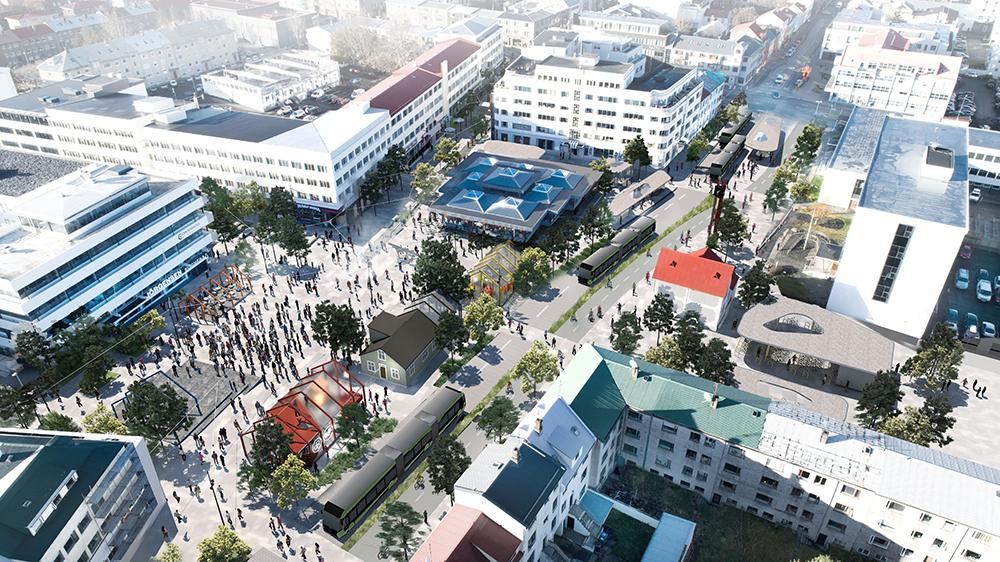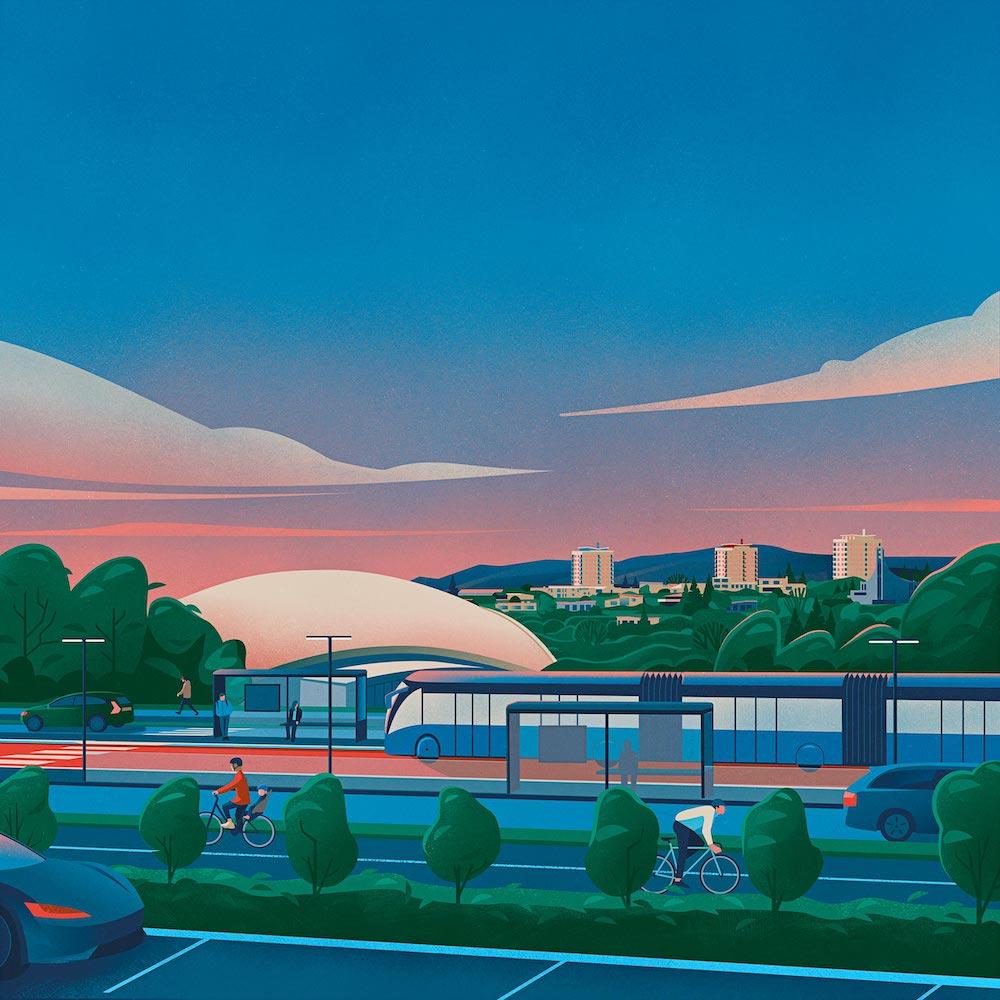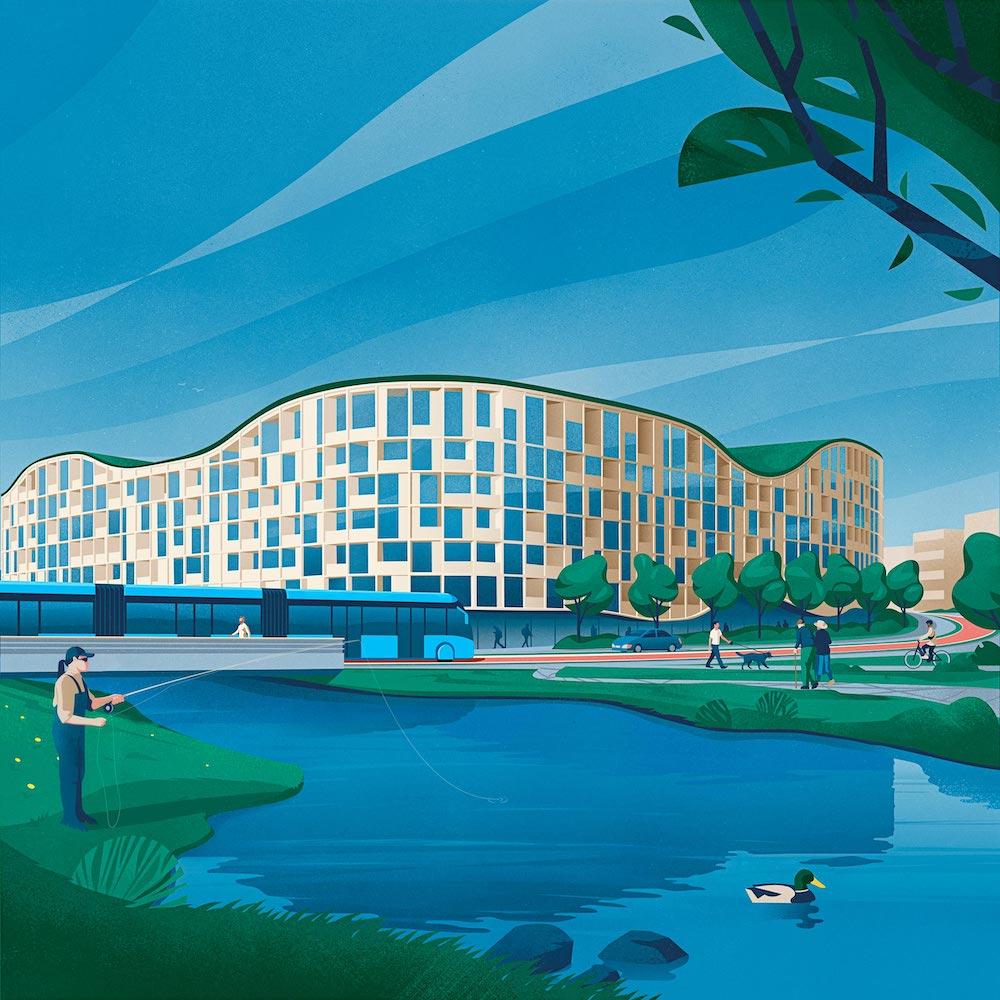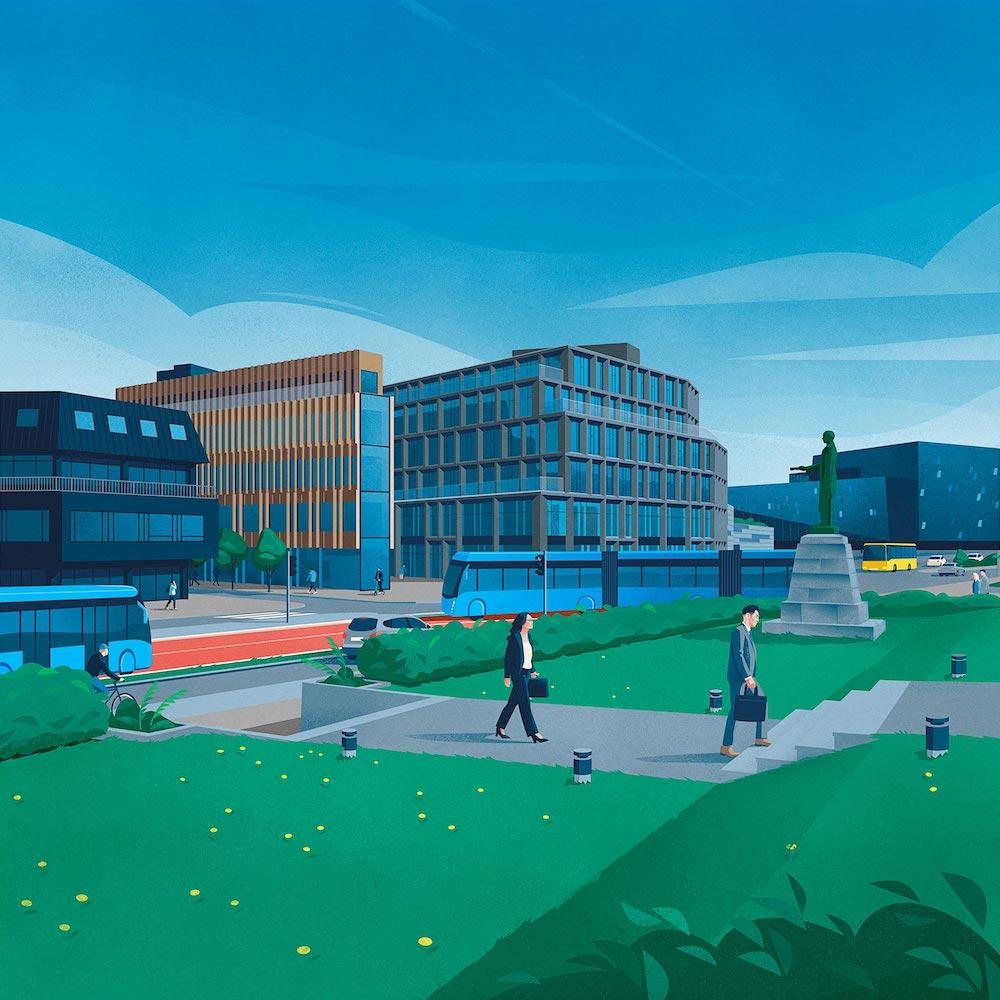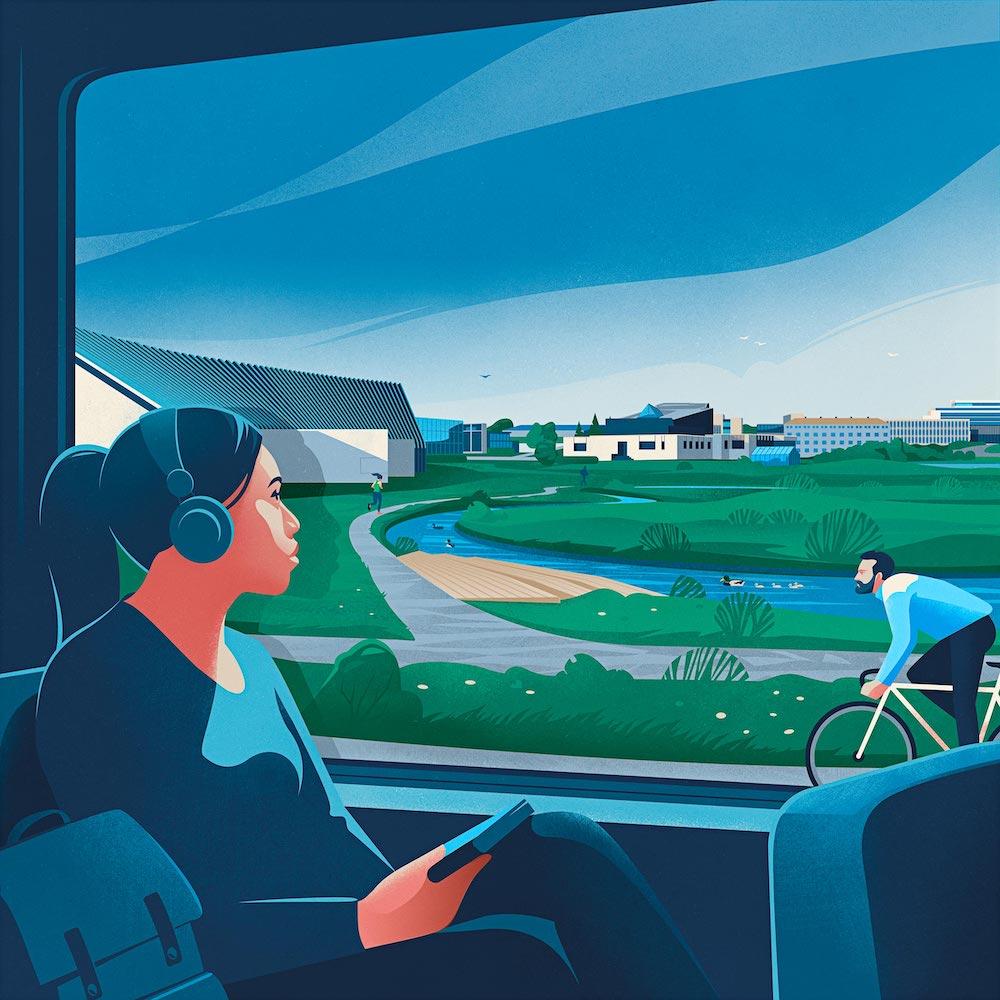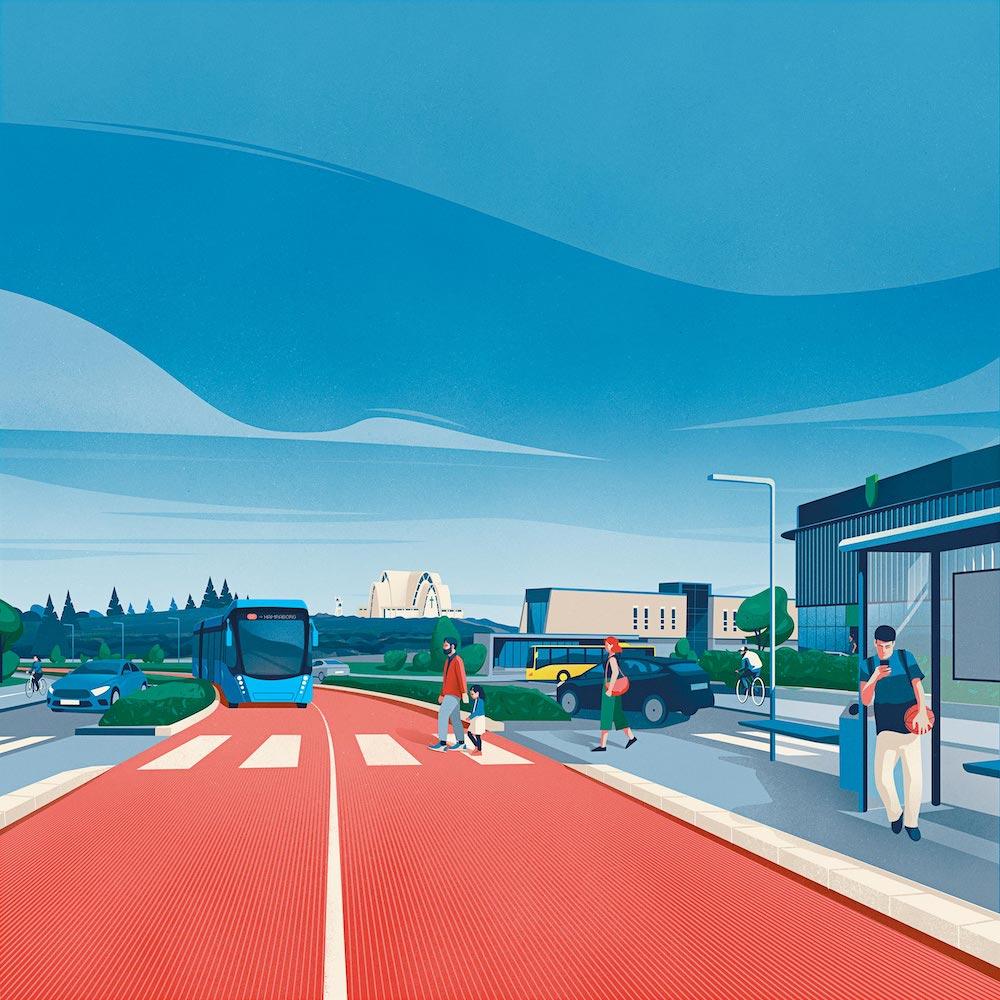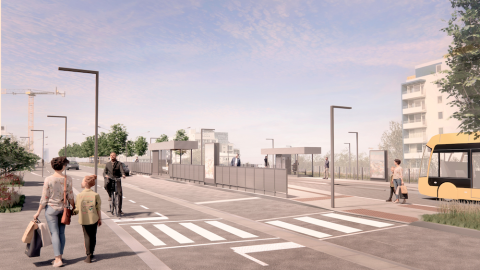CityLine
better transportation - better life
The CityLine is a new public transportation tying the city and neighboring municipalities together, improving the quality of life and simplifying daily life. With it we strengthen infrastructure, make a great city even better, and take vital steps in addressing climate change issues and improving public health.
Explanation images
City development
Transportation is closely linked to urban development, and a growing city needs efficient public transportation. Therefore, residential and commercial development goes hand in hand with the CityLine, while also emphasizing better infrastructure for cyclists and pedestrians. This development supports economic growth and allows as many people as possible to travel in an environmentally friendly manner.
Urban development zones in Reykjavík are lined along a development axis that has been defined in the municipal plan for a longer period. This way, land use is optimized, and Reykjavík develops like sought-after urban areas abroad by offering diverse transportation options and shorter distances for people in everyday life.
Main development areas in Reykjavík
A map view is available below, and you can also explore housing development in a separate window.
Public health
When developing the City, it is important to consider public health and the well-being of those affected by the changes. With the CityLine, the use of public transportation and active travel modes, such as walking and cycling, will increase. This integrates physical activity into everyday life, positively impacting mental and physical health. At the same time, premature deaths decrease.
Public health also involves connections, and with the CityLine, access to various destinations and services will improve, further enhancing social cohesion and equality. Good and accessible public transportation prevents isolation and exclusion of certain groups.
Reykjavík City is a leader in public health matters and has decided, in collaboration with Better Transport, to conduct the first forward-looking public health assessment in Iceland.

Questions and answers
Why does CityLine have a positive impact on physical health?
Using public transportation increases opportunities for physical activity and outdoor recreation. Increased physical activity, such as walking or cycling to a stop, makes it more likely that people will meet daily physical activity guidelines. Research shows that increased use of public transportation has positive effects on physical health, both in terms of increasing physical activity and reducing the incidence of common diseases such as diabetes, heart and vascular diseases, and premature deaths.
Why does CityLine have a positive impact on mental health?
Research shows that active travel and improved public transportation have positive effects on mental health, especially stress. Studies also indicate that increased use of public transportation can reduce symptoms of various mental disorders such as anxiety, stress, and depression. It is not only the use of public transportation that has a positive impact on mental health, but also other environmental factors.
How does CityLine reduce stress?
By carefully designing beautiful environments, slowing down traffic, and improving access for pedestrians, authorities can promote increased physical activity, create attractive and positive environments, and increase social capital. All these factors have a positive impact on mental health and well-being, reducing stress. The connection between quality of life and commuting has also been studied, with long travel times in traffic having negative effects on mental health, potentially increasing stress, especially for those traveling by car.
What about children?
Improved facilities and increased use of public transportation among children can lead to less shuttling to and from homes to friends' houses and leisure activities and sports. Physical activity related to using public transportation increases children's physical activity and positive effects on their health just like organized sports. Physical activity and increased outdoor recreation also have positive effects on mental health. It can be expected that the freedom of young people will increase with longer service hours and increased frequency of vehicles.
Diverse transportation options
One of the key features of the CityLine is that it mostly travels in dedicated lanes with priority at intersections. This means delays are minimized, and travel time is reduced, as CityLine vehicles will pass private cars during peak hours based on current traffic conditions. The frequency of service will also increase compared to current public transportation.
It is essential to offer a reliable public transportation system for the public, as the population in the capital area has grown by about 90 people per week in recent years, resulting in an increase of about 50 cars on the roads every week. This means more traffic congestion and pollution if we do not change our behavior and start using diverse transportation options.
Approximately 70% of all greenhouse gas emissions in Reykjavík are due to vehicles using fossil fuels such as gasoline and diesel.
Climate change
The main cause of greenhouse gas emissions in Reykjavík is road transportation, primarily through the use of private cars. Therefore, there is much to gain by reducing private car trips, such as using the CityLine for commuting to and from work or school.
Reykjavík City's goal is to become carbon neutral by 2040. Carbon neutrality describes a state where a balance has been achieved between the rate of emission and absorption of human-induced greenhouse gases, resulting in net-zero emissions. The goal is also to adapt to climate change in an environmentally and human-friendly way.
Energy transitions are part of this plan, with CityLine vehicles set to be electric.

Urban environment
The CityLine not only improves transportation in the capital area but also affects the environment around the line.
It is interesting to see how the CityLine interacts with the urban environment around it.
We are planning to have good connections to CityLine stations as you need to be able to access the services easily.

Questions and answers
How does CityLine improve the appearance of the environment it passes through?
Improved walking and cycling paths, increased vegetation, and recreational areas are planned along the CityLine. Traffic near the CityLine is expected to be slow urban traffic with safe pedestrian crossings. Lighting and service levels along pedestrian routes will be improved, including winter maintenance. Distinctive bike paths and sidewalks along the CityLine will make it easier for residents and city visitors to find their way to CityLine stations.
How can CityLine simplify pedestrian - and bike paths within neighborhoods?
We will review the neighborhood path systems during the construction of the CityLine. It is essential that the path system supports and ensures easy walking routes from neighborhoods to CityLine stations. Good walking - and cycling paths will also run along the CityLine. CityLine stations will include spaces for various types of bicycles and solutions that simplify the last leg of the journey home or to work.
How can CityLine support the development of 15-minute neighborhoods in the city?
We are planning to increase service levels and improve conditions around CityLine stations to accommodate the increased number of people in the area, thus creating a solid basis for such operations. Targeted densification areas along the CityLine corridors support increased human activity, small cores, and services for residents. This shortens service distances within neighborhoods. The densification areas also promote increased basic services.
How can CityLine make the city greener and more environmentally friendly?
Along the CityLine route, increased vegetation, street trees, and Sustainable Drainage Systems (SuDS) are planned. The goal of SuDS is to allow surface water to infiltrate the soil in the most natural way possible, such as through vegetation beds. This better utilizes water resources and makes the city more adaptable to climate change. In addition, these solutions also affect the conditions for growing street trees, and both vegetation and trees help to capture carbon.
For household finances
Better public transportation has positive effects on household finances. The purchase and operation of vehicles are roughly as significant an expense as food and drink.
Based on an analysis by Statistics Iceland on private consumption, it can be estimated that residents of the capital area have spent an average of nine billion ISK per month on the purchase and operation of their vehicles in recent years.
There are 1.7 private cars on average per household, so it is clear that many households can save a significant amount of money by getting rid of one car.
Furthermore, the introduction of the CityLine has positive financial effects on those who cannot currently use public transportation, as it will be more accessible to many.
Savings for society
Investment in the first phase of the CityLine yields a social benefit of up to 26 billion kr. The project's rate of return is estimated at just under 7%. This is revealed in a socioeconomic analysis of the CityLine.
The analysis takes into account all impact factors and assesses direct and indirect costs and benefits, from construction and operation costs to time savings and environmental impacts.
To assess reliability, a separate analysis was conducted on specific cost factors, in addition to a 50% uncertainty allowance. It shows that the project maintains social benefits, despite significant changes.
CityLine illustrations
CityLine Zoning Plan
To make the CityLine a reality, zoning plans need to be developed for the entire line. In Reykjavík, there are about 20 zoning plans, and about 30 adjacent zoning plans need to be adjusted for this first phase.
The CityLine's infrastructure is in the design process at the CityLine Project Office. The Office has domestic and foreign experts with experience in similar projects and an international design team working there. Urban design, transportation, and planning collaborate with the CityLine Project Office and Transport for the Capital Area (TfCA) in preparing the project.
The zoning plan process runs parallel to the CityLine's design process and is carried out in cooperation with the CityLine's design team. As a resident, you have the opportunity to provide suggestions and comments when the relevant zoning plan is advertised.
Public notice:
Transportation Agreement
The national government and six municipalities signed a Transportation Charter for the capital area in 2019. The agreement includes a shared vision and comprehensive plan for the entire region. It aims to improve safety, enhance transportation for all modes, reduce delays and boost public transit. An updated Transportation Charter was signed in August 2024.
The Green Deal
The City of Reykjavík's overall strategy outlines the City's vision for the future up to 2030 and connects the City's key policies and plans to that vision.
Planning
Planning addresses the arrangement of built areas and the shaping of the environment. A land use plan is a detailed implementation of a municipal plan for a specific area or plot.
Climate change
The goal is to become carbon neutral by 2040 and to adapt to climate change in an environmentally and human-friendly way.
CityLine
More on the CityLine as a high-quality public transportation system and the network that connects municipalities together.
Better Transport
The implementation of the State and Municipalities Transportation Agreement is in the hands of Transport for the Capital Area (TfCA).
Public Roads Administration
The Icelandic Road and Coastal Administration maintains highways and handles road construction, services and maintenance.











